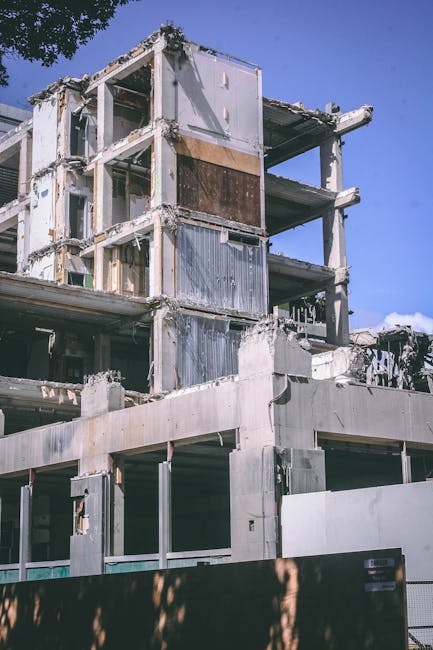 The Art of Concrete Demolition in Hawaii: A Guide to Efficient and Safe Removal
The Art of Concrete Demolition in Hawaii: A Guide to Efficient and Safe Removal
When it comes to concrete demolition in Hawaii, it’s essential to approach the task with caution and expertise. The Aloha State is known for its beautiful beaches, lush rainforests, and vibrant cities, but beneath the surface lies a complex network of infrastructure, including roads, buildings, and bridges, all made of concrete. As these structures age and become obsolete, they require careful removal to make way for new developments and infrastructure projects. In this article, we’ll delve into the world of concrete demolition in Hawaii, exploring the techniques, challenges, and best practices for efficient and safe removal.
1. Why Concrete Demolition is Necessary
Concrete demolition is a crucial step in the construction process, as it allows for the removal of old, damaged, or obsolete structures to make way for new ones. In Hawaii, where the climate is humid and corrosive, concrete structures are particularly prone to damage and deterioration. As a result, concrete demolition is a common occurrence in the state, particularly in urban areas where infrastructure is aging and in need of replacement.
2. Types of Concrete Demolition
There are several methods used in concrete demolition, each with its own advantages and disadvantages. The most common techniques include:
* Mechanical demolition: This involves using heavy machinery, such as excavators and wrecking balls, to break down the concrete structure.
* Chemical demolition: This method involves using chemicals to break down the concrete, often used for smaller-scale projects.
* Hand demolition: This is a labor-intensive process that involves manually breaking down the concrete using hand tools.
Each method has its own set of challenges and considerations, and the choice of technique will depend on the specific project requirements and site conditions.
3. Challenges of Concrete Demolition in Hawaii
Demolishing concrete structures in Hawaii presents several unique challenges. The state’s tropical climate, with high temperatures and humidity, can cause concrete to deteriorate rapidly, making it more difficult to remove. Additionally, the island’s rugged terrain and limited access to some areas can make it difficult to transport heavy machinery and equipment. Furthermore, the state’s strict environmental regulations and concerns about noise pollution require careful planning and execution to minimize disruption to the surrounding environment.
4. Best Practices for Concrete Demolition
To ensure efficient and safe concrete demolition in Hawaii, it’s essential to follow best practices. These include:
* Conducting thorough site assessments to identify potential hazards and obstacles.
* Developing a detailed demolition plan, including a timeline and budget.
* Using personal protective equipment (PPE) and safety gear to protect workers from potential hazards.
* Implementing noise reduction measures to minimize disruption to the surrounding environment.
* Recycling and reusing materials whenever possible to reduce waste and minimize environmental impact.
5. Environmental Considerations
Concrete demolition in Hawaii requires careful consideration of environmental factors. The state’s unique ecosystem and fragile environment make it essential to minimize the impact of demolition activities. This includes:
* Implementing measures to prevent soil erosion and sedimentation.
* Protecting nearby waterways and habitats from contamination.
* Recycling and reusing materials to reduce waste and minimize environmental impact.
* Conducting thorough cleanup and disposal of hazardous materials.
6. Safety Considerations
Safety is a top priority in concrete demolition, particularly in Hawaii where the terrain and climate can be unforgiving. To ensure worker safety, it’s essential to:
* Conduct thorough site assessments to identify potential hazards and obstacles.
* Develop a detailed safety plan, including emergency procedures and evacuation routes.
* Provide personal protective equipment (PPE) and safety gear to protect workers from potential hazards.
* Implement noise reduction measures to minimize disruption to the surrounding environment.
7. Cost-Effective Solutions
Concrete demolition in Hawaii can be a costly and time-consuming process. To minimize costs and maximize efficiency, it’s essential to:
* Develop a detailed demolition plan, including a timeline and budget.
* Identify opportunities for recycling and reusing materials.
* Implement cost-effective demolition techniques, such as mechanical demolition.
* Minimize waste and environmental impact to reduce disposal costs.
8. Conclusion
Concrete demolition in Hawaii is a complex and challenging process that requires careful planning, execution, and attention to detail. By understanding the techniques, challenges, and best practices involved in concrete demolition, you can ensure efficient and safe removal of old structures to make way for new developments and infrastructure projects. Whether you’re a contractor, developer, or homeowner, it’s essential to approach concrete demolition with expertise and caution to minimize disruption to the surrounding environment and ensure a successful outcome.